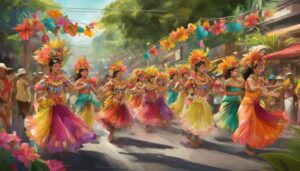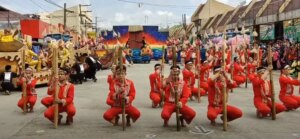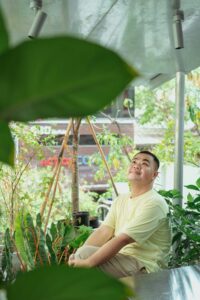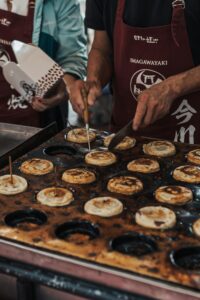Abrenian Kawayan Festival is a cultural celebration that brings to life the rich heritage and resilient spirit of the people of Abra, Philippines. Held annually in the province of Abra, this festival is not just a testament to the region’s deep-rooted traditions but also a tribute to the versatile bamboo, locally known as “kawayan,” which plays a central role in the lives of the Abrenians.
Through a colourful mosaic of activities, including parades, dance performances, bamboo craft exhibitions, and more, the festival showcases the ingenuity, craftsmanship, and unity of the Abrenian community.
Join us to explore this special celebration, where we’ll learn about its beginnings, importance, and the memorable moments it brings to everyone, from residents to guests.
Key Takeaways
- The Abrenian Kawayan Festival is a celebration in the province of Abra, which was previously known as Arya Abra.
- The festival was rebranded in 2009 to showcase Abra’s reputation in bamboo production.
- The festival has evolved over the years and now includes various competitions, cultural shows, and a grand parade.
- The festival also highlights women’s empowerment through events like the Women’s Day celebration.
Facts About The Abrenian Kawayan Festival Philippines
| Facts | Brief Explanation |
|---|---|
| Name of the Festival | Abrenian Kawayan Festival |
| Type of Festival | Cultural |
| City of Origin | Bangued, Abra, Philippines |
| Festival Etymology | Named after the abundant bamboo (kawayan in Filipino) in the region, symbolizing resilience and versatility. |
| Date When It Was Celebrated First | March 9, 2009 |
| Founder of the Festival | Eustaquio P. Bersamin (Governor of Abra at the time) |
| Brief History of the Festival | The Abrenian Kawayan Festival was initiated to promote Abra’s culture, traditions, and bamboo industry. It highlights the importance of bamboo in the local economy and crafts, featuring bamboo art exhibits, parades, and cultural shows. |
| Brief History of the City Where It Is Celebrated | Bangued is the capital of Abra, known for its rich history and cultural heritage. Established during the Spanish colonial period, the city has been a center of trade and governance. It showcases a blend of indigenous traditions and colonial influences. |
| Ethnic Information of the City and Region | The population primarily consists of the Tingguian (Itneg) ethnic group, alongside Ilocano settlers. The region is known for its indigenous crafts, particularly weaving and bamboo crafts. |
| Explain the Location of the City in the Country | Bangued is located in the heart of Abra province, Northern Luzon, Philippines. It is nestled in the Cordillera Administrative Region, known for its mountainous terrain. |
| How to Reach the City | – From Manila, take a bus heading to Abra (Bangued). – Major airlines fly to nearby cities like Laoag, Ilocos Norte, from where you can take a bus or hire a vehicle to Bangued. |
| Nearby and Surrounding Cities or Towns | – Vigan, Ilocos Sur – 130 km – Baguio City – 150 km – Laoag, Ilocos Norte – 180 km |
| Google Map Link to the City Location | Google Maps – Bangued, Abra |
| Bullet List of Festival Main Events and Activities | – Bamboo Craft Exhibits – Cultural Parades – Traditional Dance Performances – Bamboo Cooking Contests – Beauty Pageants |
| Famous Tourist Attractions and Landmarks in the City | – Cassamata Hill National Park (Offers panoramic views of Bangued and the province of Abra) – Don Mariano Marcos Bridge (One of the longest bridges in the Philippines, providing scenic views of the Abra River) – Victoria Park (A serene park ideal for relaxation and family picnics) |
| Famous Food Dishes of the City | – Miki (a local noodle soup) – Abrenian empanada (a unique take on the Filipino empanada, filled with local ingredients) |
| Bullet List of Related Festivals | – Arya! Abra Festival (A celebration of Abra’s foundation anniversary) – Tingguian Festival (Showcases the culture and traditions of the indigenous Tingguian people) |
Why Abrenian Kawayan Festival Philippines is celeberated?
The Abrenian Kawayan Festival in the Philippines is celebrated to commemorate the founding anniversary of the province of Abra, which was established as an independent province from Ilocos Sur on March 9, 1917. The festival, previously known as Arya Abra Festival, is a cultural celebration that highlights the ubiquity of bamboo and the province’s bamboo industry. It features a variety of activities such as beauty pageants, street dance parades, and exhibits of local bamboo products, showcasing the beauty and cultural heritage of the province, and promoting its tourism and economy.
Festival Origins and Evolution
The festival was originally known as Arya Abra, a name reflecting the province’s identity and spirit. In 2009, it was rebranded to the Abrenian Kawayan Festival to better showcase Abra’s bamboo industry and its significance to the community’s way of life.
This rebranding was spearheaded by then-Governor Eustaquio P. Bersamin, aiming to promote the province’s cultural, economic, and artistic landscapes through the versatile bamboo.
Cultural Significance
Bamboo plays a pivotal role in the lives of the Abrenians, symbolizing resilience and versatility. The festival embodies these qualities, showcasing the ingenuity and craftsmanship of the locals through a series of events such as bamboo craft exhibitions, cultural parades, traditional dance performances, and bamboo cooking contests.
It also highlights women’s empowerment and includes a beauty pageant, further emphasizing the community’s values and cultural pride.
Evolution of the Festival
Over the years, the Abrenian Kawayan Festival has evolved from a local festivity into a significant cultural event that attracts visitors from across the Philippines and even international guests. It has grown to include various competitions, cultural shows, and a grand parade, reflecting the province’s journey from a historical ally in uprisings to a distinct cultural hub.
This evolution mirrors Abra’s rich past and its aspirations for the future, making the festival a symbol of pride and progress for the Abrenian people.
Annual Event Highlights
As you explore the Abrenian Kawayan Festival, you’ll discover that the event’s highlights have become a beacon of Abra’s vibrant culture, with activities ranging from traditional shows to modern competitions. The festival honors the local bamboo industry, showcasing intricate crafts and innovative bamboo products, reinforcing its significance to the region’s identity and economy.
You’ll witness the economic impact of the festival as it attracts visitors, stimulating local businesses and trade. The grand parade mesmerizes with floats that exhibit the ingenuity of Abrenian artisans, while the trade fair offers a chance to support local entrepreneurs.
The festival’s dynamic blend of cultural pride and economic vitality isn’t just entertaining—it’s a testament to the community’s resilience and creativity.
Beauty Pageant Traditions
The festival’s celebration of bamboo craftsmanship seamlessly transitions into its beauty pageant traditions, where you’ll find the community’s spirit and cultural identity shining through the array of pageants. These events hold historical significance, as they reflect the region’s evolution and commitment to celebrating both beauty and the rich tapestry of local traditions.
The impact on the local community is profound. Pageants during the Abrenian Kawayan Festival foster unity, provide entertainment, and create opportunities for local talents to shine. They also attract visitors, which boosts the local economy.
Cultural Exhibitions and Contests
You’ll find that cultural exhibitions and contests are at the heart of the Abrenian Kawayan Festival, showcasing the province’s rich heritage and artistic flair. As you immerse yourself in the festivities, you’ll witness a vibrant handicraft showcase, where local artisans display their bamboo craft, weaving intricate patterns that tell stories of Abra’s history and craftsmanship.
Not to be missed are the traditional dances, a rhythmic expression of the province’s soul. Competitors pour their passion into every step, offering you a glimpse into the ancestral beats that have pulsed through the region for generations.
Interesting Facts About The Abrenian Kawayan Festival Philippines
- 🎋 The Abrenian Kawayan Festival in the Philippines celebrates the abundance and versatility of bamboo, an integral part of Filipino culture and daily life.
- 🪑 The festival features various activities such as bamboo raft racing, where participants construct rafts solely from bamboo and navigate them through designated waterways, showcasing the ingenuity of bamboo craftsmanship.
- 🎶 Traditional bamboo musical instruments, like the kulintang (a set of gongs) and the tongatong (bamboo percussion instrument), are prominently featured during the festival, adding a rhythmic flair to the celebrations.
- 🎨 Artisans showcase their skills in bamboo carving, weaving, and other crafts, demonstrating the aesthetic and functional possibilities of this sustainable material.
- 🎉 One highlight of the festival is the street dance competition, where participants clad in vibrant costumes perform choreographed routines inspired by the movements of bamboo and the rhythms of nature.
- 🍲 Food stalls offer a variety of bamboo-inspired delicacies, from bamboo shoots cooked in various ways to bamboo-infused beverages, allowing visitors to indulge in the flavours of the festival.
- 🏞️ Environmental awareness plays a significant role in the Abrenian Kawayan Festival, with initiatives promoting bamboo cultivation and conservation efforts to preserve natural resources and biodiversity.
- 🎊 The festival provides a platform for local communities to showcase their cultural heritage and craftsmanship, fostering pride and solidarity among residents of Abra province.
- 🌱 Educational workshops and demonstrations educate visitors about the sustainable uses of bamboo, highlighting its potential in eco-friendly construction, furniture making, and even as a renewable energy source.
- 📜 The Abrenian Kawayan Festival aims to promote tourism and economic development in the region while preserving and celebrating the rich tradition of bamboo culture in the Philippines.
Visiting Abra for the Festival
Here’s a guide to help you make the most of your visit to Abra during this special celebration:
Before You Go
- Research and Plan: Familiarize yourself with the festival’s schedule, which includes bamboo craft exhibits, cultural parades, traditional dance performances, bamboo cooking contests, and beauty pageants. Planning ensures you don’t miss out on key events.
- Accommodations: Book your stay well in advance. Options range from local inns to hotels. Early booking is crucial as accommodations can fill up quickly due to the influx of visitors during the festival.
- Transportation to Abra: From Manila, you can take a bus directly to Bangued, the capital of Abra. Alternatively, you can fly to nearby cities like Laoag in Ilocos Norte and then take a bus or hire a vehicle to Bangued.
During the Festival
- Local Cuisine: Don’t miss out on trying Abra’s local dishes such as Miki (a local noodle soup) and Abrenian empanada. Food stalls and local markets are great places to explore the authentic taste of Abra.
- Cultural Immersion: Attend the scheduled shows, parades, and performances in town plazas and other venues. These events are a deep dive into the culture and traditions of Abra, offering a memorable experience.
- Transportation Within Abra: For getting around Bangued and nearby areas, tricycles and jeepneys are common and convenient modes of transportation. Planning your travel within the province can help you navigate the festivities stress-free.
- Festival Itinerary: Keep a festival itinerary handy. With multiple activities happening, having a schedule allows you to catch the exciting highlights and manage your time effectively.
Tips for a Better Experience
- Respect Local Customs: Abra’s community is rich in traditions. Showing respect and openness to their customs and way of life will enhance your experience and interaction with locals.
- Stay Hydrated and Protected: The festival involves outdoor activities, so it’s important to stay hydrated and use sun protection.
- Local Support: Participating in the festival by supporting local artisans and businesses, such as buying local crafts or food, contributes to the community and gives you a tangible piece of the culture to take home.
Famous Food of the Festival Abrenian Kawayan Festival Philippines And The Region
The festival, along with the region itself, offers a variety of unique and delicious dishes that reflect the rich food culture of Abra and the surrounding areas. Here are some of the famous foods associated with the Abrenian Kawayan Festival and the region:
1. Miki
Miki is a local noodle soup that is a staple in Abra. This hearty and comforting dish is made with homemade egg noodles served in a rich and flavorful broth, often garnished with chicken, pork, or vegetables. It’s a must-try for visitors seeking to experience the local cuisine.
2. Abrenian Empanada
The Abrenian empanada offers a unique take on the classic Filipino empanada. Filled with local ingredients such as green papaya, egg, and ground meat, it’s then deep-fried to golden perfection. This snack is not only popular during the festival but is also a beloved street food in the region.
3. Bagnet
Although more widely known as a dish from the Ilocos Region, Bagnet, a crispy deep-fried pork belly, is also popular in Abra. It’s often served with a side of pickled vegetables (atchara) or dipped in a spicy vinegar sauce.
4. Pinakbet
Pinakbet, a vegetable stew flavoured with bagoong (fermented fish or shrimp paste), features a mix of indigenous vegetables such as bitter melon, eggplant, tomato, okra, and string beans. It often includes pieces of pork or bagnet for added flavour.
5. Sinanglao
Sinanglao is a sour beef soup that is another specialty of the region. It’s made with beef innards and flavoured with bile, making it distinctively tangy. This dish is particularly popular as a breakfast meal among locals.
6. Inasinan
Inasinan refers to various dishes prepared with salted or preserved meats or fish. In Abra, this could include salted pork or fish, often cooked with indigenous vegetables or served as a side dish with rice.
RegionalSweets and Delicacies
- Patupat: A sweet sticky rice cake wrapped in palm or banana leaves, often enjoyed as a snack or dessert.
- Binungey: Bamboo-cooked sticky rice, sometimes mixed with coconut milk, offering a unique taste and texture that reflects the bamboo theme of the festival.
How to Reach Bangued, Abra, Philippines
To reach Bangued, the capital of Abra province in the Philippines, there are several options depending on your preference for convenience, budget, and travel time. Here’s a comprehensive guide based on available information:
By Bus
- Direct Bus from Manila: This is the most straightforward and economical way to reach Bangued. Several bus companies operate daily trips from Manila to Bangued. Companies like Partas, Dominion, and Viron Bus offer these services, with travel times averaging around 8 to 9 hours. Tickets can range from ₱700 (Philippines Pesos) to ₱1,000(Philippines Pesos). Buses depart from terminals in Cubao and Pasay.
- Bus Schedules: Buses have various departure times throughout the day and night, offering flexibility for travellers. It’s advisable to check the latest schedule and book your tickets in advance, especially during peak travel seasons or festivals.
By Plane and Bus Combination
- Flying to Nearby Cities: For a quicker but more costly option, you can fly from Manila to Laoag, Ilocos Norte, which is served by airlines like Cebu Pacific and Philippine Airlines. From Laoag, you can take a bus to Vigan, Ilocos Sur, and then another bus directly to Bangued. This option reduces road travel time but requires coordinating flight and bus schedules.
By Car
- Driving: If you prefer to drive, the journey from Manila to Bangued can be quite scenic and adventurous. The trip takes approximately 8 hours, depending on traffic and weather conditions. You’ll drive north via the North Luzon Expressway (NLEX), continuing onto the Tarlac-Pangasinan-La Union Expressway (TPLEX), and following the national highways through Ilocos Region or the mountainous Cordillera roads leading directly to Abra. Ensure your vehicle is in good condition and be prepared for long stretches of driving.
Travel Tips
- Planning: Regardless of your mode of transport, it’s crucial to plan your trip, especially during the Abrenian Kawayan Festival when the region sees a surge in visitors.
- Accommodations: Book your accommodations early to secure a place to stay upon arrival in Bangued.
- Local Transportation: Upon reaching Bangued, tricycles and jeepneys are available for local transportation to get around the town and nearby attractions.
Location Of The Bangued, Abra, Philippines
Famous Historical Places In Bangued, Abra, Philippines
Bangued, the capital of Abra province in the Philippines, is rich in historical landmarks that reflect its cultural heritage and architectural significance. Here are some famous historical places to visit in Bangued, Abra:
- St. James the Elder Cathedral: Also known as the Bangued Cathedral, this church is a prominent religious landmark in Bangued. Its grandeur and historical importance make it a must-visit for tourists interested in architecture and religious heritage.
- San Lorenzo Ruiz Shrine: This shrine is dedicated to San Lorenzo Ruiz, the first Filipino saint canonized by the Catholic Church. It serves as a pilgrimage site for devotees and a historical attraction for visitors interested in Filipino religious history.
- Quintin Paredes Ancestral House: This ancestral house is a reminder of Bangued’s colonial past and offers insights into the lifestyle and architecture of the period. It’s a great place to learn about the local history and cultural heritage of the region.
- Cassamata Hill National Park and Viewdeck: Aside from its historical significance, Cassamata Hill National Park offers panoramic views of Bangued and the surrounding landscape. It’s an ideal spot for nature lovers and photographers seeking breathtaking vistas.
- Gabriela Silang Museum of Fine Arts: Located in Tayum, near Bangued, this museum is dedicated to Gabriela Silang, a Filipino revolutionary leader. It showcases artworks and artifacts related to her life and contributions to Philippine history.







